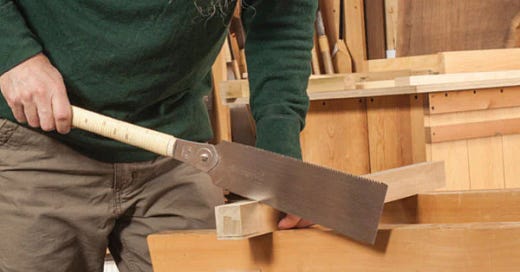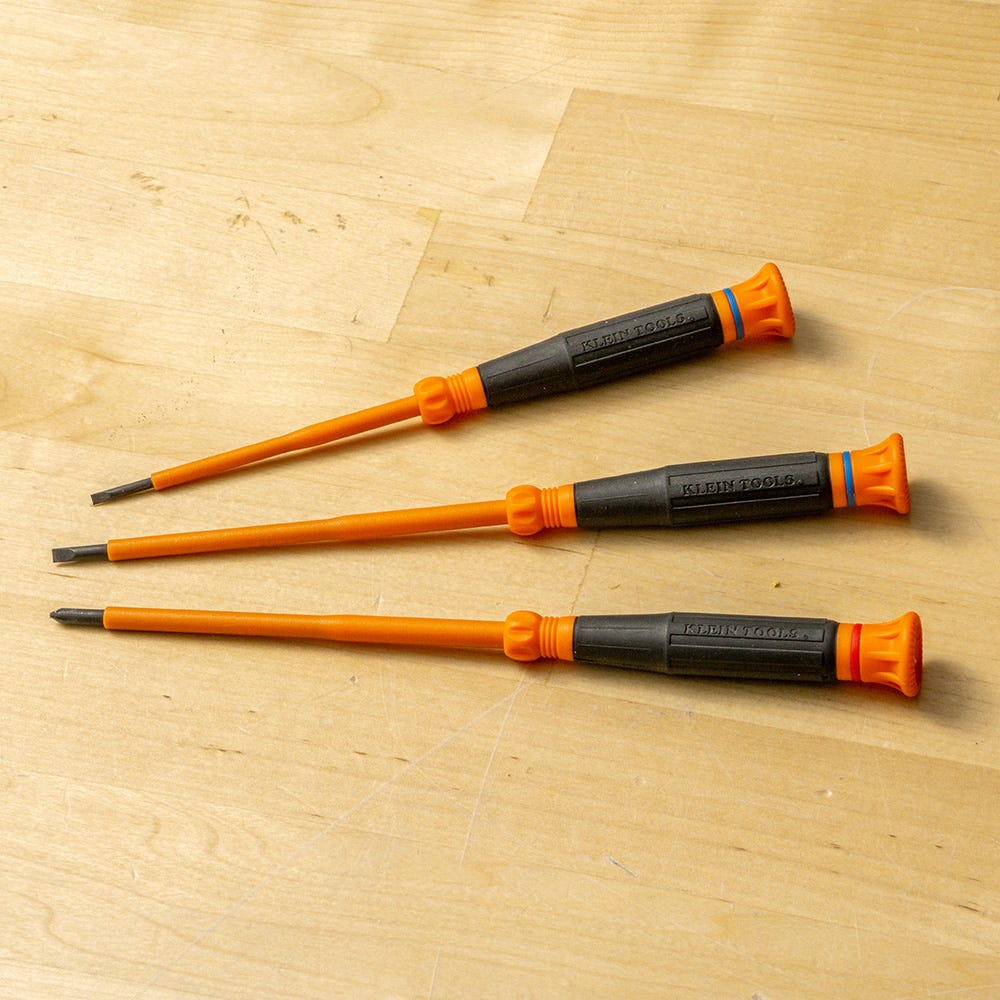I make tools for a living. I also use a lot of tools. Most of them are just fine, but a few of them have impressed me so much that I have seen in them principles for the design of good tools. Here are a few of my favorites:
The ryoba saw
The ryoba saw is a tool that exploits practical physics. Anyone who has slid a box or a piece of furniture across a floor has learned that pulling is easier than pushing. Why, then, do Western saws cut on the “push” action rather than the “pull”? A Japanese pull saw, of which the ryoba is one, does what the name implies.
By itself, this is a nice innovation. But what else does the peculiar geometry of the saw do? For one, the handle is perfectly parallel with the intended line of action. In a motion as natural as pulling a rope, you can pull the straight handle in the direction of the cut. Having a haptic reference in your hand helps keep your cut straight. For another, the blade is not perfectly parallel with the handle’s edge, but angles downward just a bit, so that the main action of the cut is not perfectly flat, but always has a slight “bite” into the wood, as long as your sawing action moves parallel with the handle. And finally, the saw is incredibly light. While some tools bring their own weight to help them work (like a hammer), the ryoba has no great heft of its own to power through a cut. It is all in the teeth and in the smooth repetitive pull of the handle. The lightness and flimsiness of the saw makes it virtually impossible to even try to muscle your way through a cut, forcing you to rely on the saw to do the work.
The saw is also two-sided. This innovation is likewise simple and obvious once explained: one side rip cuts, and the other crosscuts. Wood is anisotropic: it has vastly different properties parallel to its grain than it does perpendicular. The finer teeth of the rip cut side help you start a cut precisely, while the crosscut side has larger and more aggressive teeth for cutting across the fibers of the wood.
The ryoba saw excels as a tool because it encourages the craftsman to relax and cut in natural, low-effort, and smooth motions. Its design even makes misusing the tool less likely, because misuse of the ryoba immediately feels clumsy and ineffective.
Obsidian is hard to describe. To judge by its website, “Obsidian is the private and flexible writing app that adapts to the way you think.” In my five years of experience with the application, I have to agree on every point.
I have what I’d call a relatively poor memory. Mostly, this means that I read far more than I can easily retain. I’ve long searched for some means to keep the things I learn from reading at my fingertips for easy recall. No technique of notetaking or form of software has worked for me until Obsidian. “Adapts to the way you think” in the Obsidian marketing tagline smells like some kind of warmed-over AI nonsense, but it actually does capture a phenomenon I’ve noticed with Obsidian: as I have used it, I have slowly adapted it to the structure of the notes, thoughts, journal entries, lists, book reviews, and articles I write.
Some tools, like Linear, are what designers call “opinionated”: they have a very particular philosophy about how something is to be done, and if you don’t like it, you can find a different tool. Other tools endeavor to be infinitely configurable to the user, containing every preference and plugin imaginable. Visual Studio Code is a good example of this school of thought—here is their help page for User and Workspace Settings, a webpage that manages to almost make my scrollbar disappear.
Obsidian manages to strike a balance so perfect that it defies categorization. It is quite simple on its face: you can write text in files, and put those files into folders. But it manages to let you organize those files in the way that makes sense to you. Whether you prefer to keep things obsessively organized and tidy or your ideas come out in a jumbled mess, in Obsidian I have noticed that you end up with order, certainly, but of a loose and open-ended kind that suggests possibilities and has you hunting for connections you hadn’t yet made.
As a tool, one thing that Obsidian excels at is that it “just works.” Over its five years, it has rolled out new features and updates, but it has always remained stupidly fast, smooth, and bug-free. It has always been easy to just open up and begin writing, and just as easy to enrich that writing by relating it to past notes, thoughts, and entries.
The precision screwdriver is a tool that knows its limitations. It almost feels like a toy when you pick it up. It is light and has what at first seems like a loose cap on the end. The drivers are too narrow to comfortably interface with standard-sized screws. But this is not a general-purpose tool: it is for driving small screws with low torque. The transformative feature is the spinning cap. It lets you press your palm lightly into the back of the screwdriver, providing just enough pressure to keep the driver seated, while you spin the screwdriver with your fingers. This kind of maneuver would feel clumsy and insecure with larger and higher-torque screws, but for small precision screws, it is a perfect delight. And it is so light that it gives your hand very precise feedback about torque to avoid overtightening.
Some standard-sized screwdrivers come with a wide variety of interchangeable driver sizes, including the very small. Using them, however, is a clumsy endeavor of its own. The weight of the screwdriver makes it harder to seat the driver into the screw head. Its thicker shank is harder to spin with your fingers. The sheer power of the regular-sized driver makes it possible to strip the screw or the housing without even noticing.
The precision screwdriver excels, therefore, in a niche: unlike many other tools, weighed down by being 9, 12, 15, or 18-in-one jacks-of-all-trade, it distinguishes itself by having one function: driving small, low-torque screws. Sometimes, two tools fit to purpose are better than one all-purpose tool.
One day, when I am satisfied with it, I will add a tool of my own making here. Until then, I have some more notes to take. Happy New Year to all of you, and thanks for reading.






